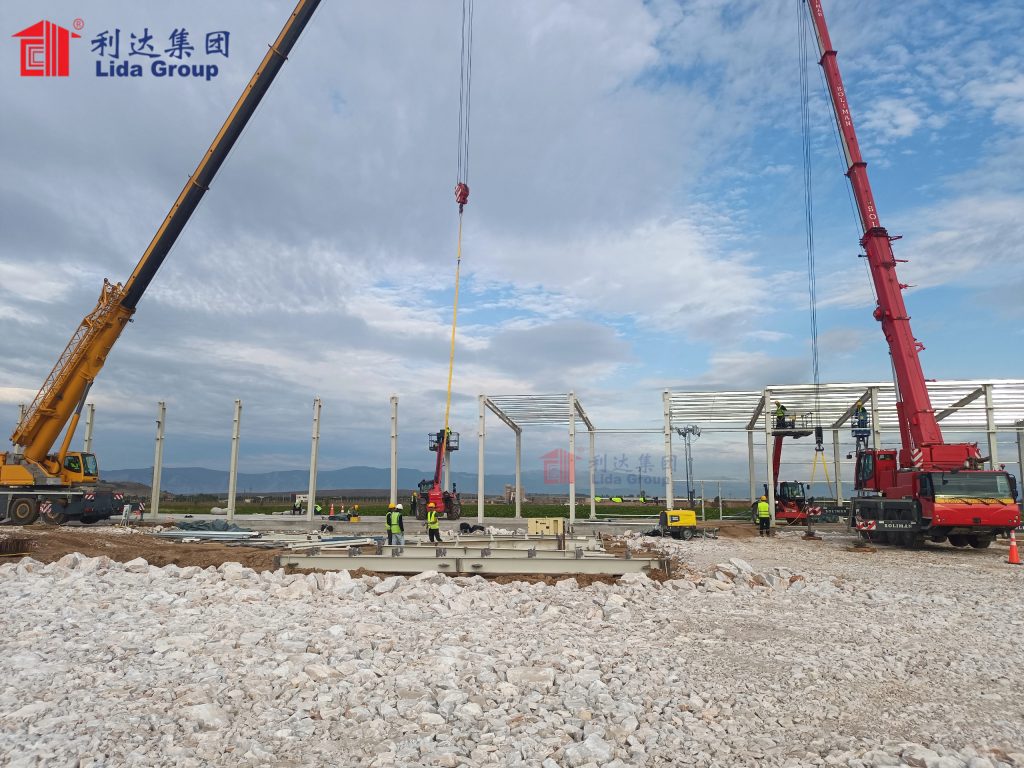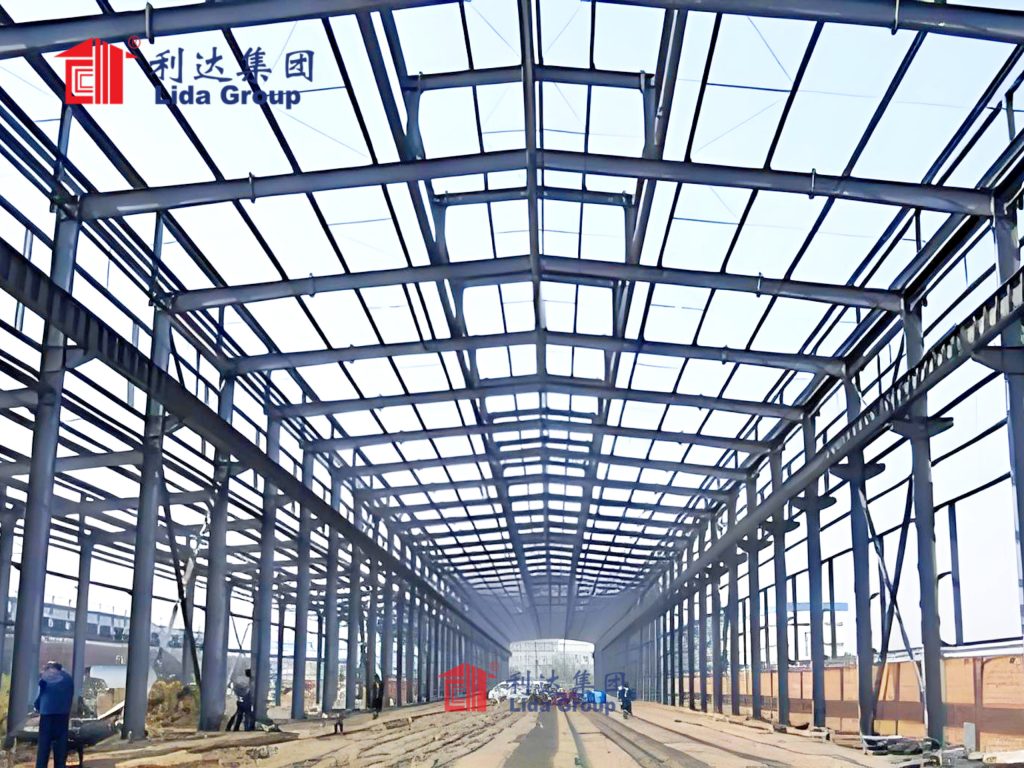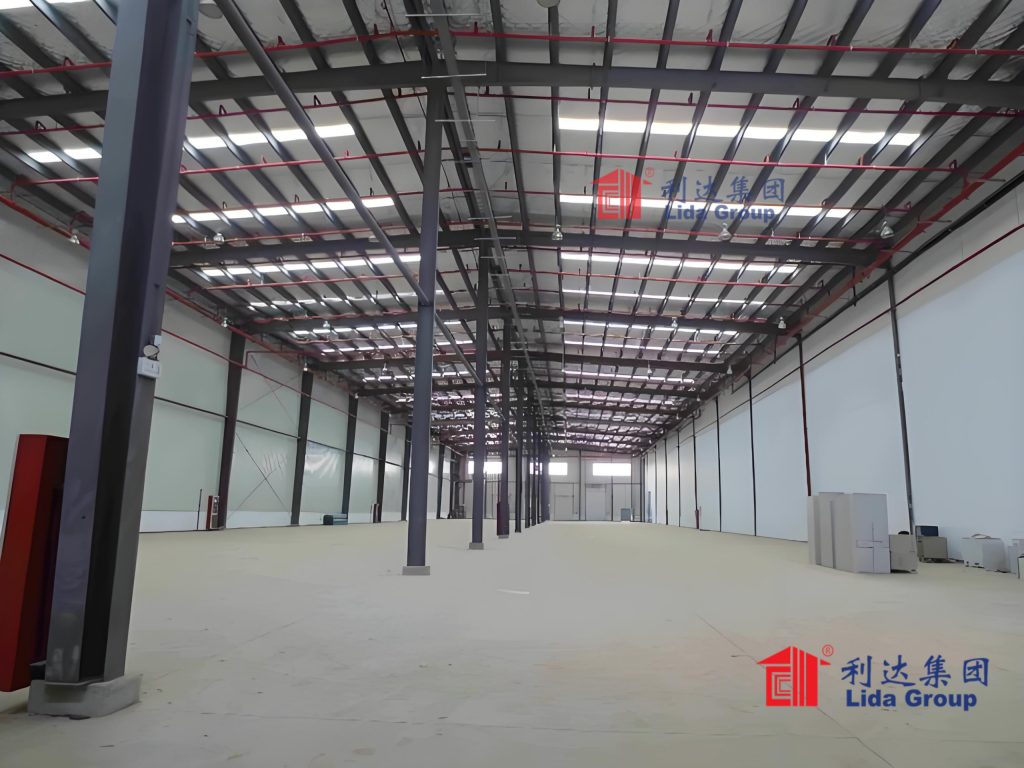Innovations in Prefab Steel Structure Construction Allow Lida Group to Deliver High Quality Metal Buildings at Unbeatable Prices
2025-Oct-15 17:49:49
By Admin
1. Introduction: The Transformation of Prefab Steel Construction
The global pre-engineered steel buildings market is experiencing unprecedented growth, projected to expand at a CAGR of 7.48% from 2025 to 2032, reaching USD 37.30 billion by the end of the forecast period . This surge is driven by urgent industry needs: e-commerce giants demand faster fulfillment centers, manufacturers require supply chain optimization, and all sectors face pressure from labor shortages and sustainability mandates . In China, the market is growing even faster at a 12% annual rate, fueled by “dual carbon” policies and urbanization . Amid this transformation, Lida Group, a manufacturer with 30 years of experience, has emerged as a global leader by redefining prefab steel structure construction. Through integrated innovations in design, manufacturing, materials, and logistics, the company consistently delivers metal buildings that outperform traditional constructions in durability and functionality while maintaining unbeatable price points. This article explores how Lida’s technological breakthroughs resolve the industry’s long-standing trade-off between quality and cost.
2. The Industry Imperative for Innovation
Traditional construction methods have become untenable in today’s fast-paced market. Conventional steel buildings suffer from extended timelines (often double that of prefab alternatives), cost overruns averaging 15-20%, and quality inconsistencies due to on-site weather variations . Modern structural demands—such as 500 kg/m² live load support for mezzanines, ±0.5°C temperature stability for cold storage, and millimeter-level floor flatness for robotic systems—further expose the limitations of traditional approaches .
Labor shortages exacerbate these issues: skilled welders are scarce globally, driving up on-site labor costs by 30% in the past five years . Meanwhile, sustainability regulations require 40% carbon reduction in new constructions, a target traditional building methods cannot meet without sacrificing affordability . These challenges created an urgent need for a new construction paradigm—one that Lida Group answered through systemic innovation.

3. Lida Group’s Core Innovation Ecosystem
3.1 Digital Design: Precision Before Fabrication
Lida’s innovation journey begins with computational design, eliminating costly errors before production starts. The company employs BIM (Building Information Modeling) and FEM (Finite Element Method) simulations to optimize every structural component . For example, when designing a 25,000 m² bulk storage warehouse for Rio Tinto, Lida’s engineers used digital prototyping to simulate seismic activity, hurricane-force winds, and thermal expansion over 50 years . This digital foresight reduced field design changes by 92%—a critical factor in avoiding expensive rework .
Digital twin technology further enhances precision by creating virtual replicas of buildings. For cold storage facilities, computational fluid dynamics (CFD) optimizes airflow around refrigeration units, while vibration analysis ensures structural stability for automated sortation equipment . This level of simulation guarantees that buildings perform as engineered from day one, eliminating the “break-in” period common with traditional construction.
3.2 Intelligent Manufacturing: Factory-Grade Quality at Scale
Lida’s climate-controlled factories represent the pinnacle of prefab steel manufacturing efficiency. The company has integrated fully automated production lines that handle cutting, welding, and coating with sub-millimeter precision . Robotic welders achieve 0.2 mm tolerances—accuracy impossible on open construction sites—while CNC machines notch connection points using laser guidance .
This automation delivers dual benefits: quality consistency and cost reduction. Unlike on-site welding, which varies with worker skill and weather, factory welding produces uniform joints certified to AISI, ASTM, and GB standards . Meanwhile, production efficiency has surged: Lida’s H-beam 生产线 completes assembly, welding, and 矫正 in one pass, boosting output by 400% compared to traditional processes . The company now produces 6,000 tons of steel components monthly, leveraging economies of scale to lower unit costs .
Surface treatment is another manufacturing breakthrough. Lida applies nano-ceramic coatings in controlled environments, providing 10 years of corrosion protection in coastal regions—where salt spray typically degrades structures within 3-5 years . This process eliminates the need for frequent maintenance, reducing long-term ownership costs for clients.
3.3 Material Science: Stronger, Lighter, More Affordable
Lida’s material innovations resolve the classic dilemma of “strength vs. cost.” The company primarily uses high-strength S550MC steel, which offers 45% greater yield strength than conventional Q235 steel while reducing material usage by 25% . For a 5,000 m² warehouse in North America, this translated to 120 fewer tons of steel without compromising load capacity .
Composite materials further enhance performance and affordability. Lida’s wall systems integrate aerogel insulation—with R-40 thermal values—into slim profiles ideal for cold storage . In a European warehouse project, these panels reduced energy consumption by 35% compared to traditional insulation, while their lightweight design cut transportation costs by 18% .
The company also practices circular economy principles: 94% of steel components are recyclable at decommissioning, and modules are often redeployed across multiple projects . This sustainability not only meets global environmental standards but also reduces raw material costs by 12% through recycling programs .
3.4 Logistics and Assembly: Accelerating Delivery Without Compromise
Lida’s innovations extend beyond the factory floor to the supply chain. The company uses containerized componentization, packing structural members to maximize transport density . For a Middle Eastern warehouse project (55m × 15.3m × 11.2m), this reduced shipping volume by 27% compared to loose component transport .
AI-powered logistics further optimize efficiency. Route optimization algorithms account for weather, traffic, and permit restrictions, while custom trailers eliminate escort requirements for oversized members . For Rio Tinto’s project, these measures cut transportation time by 14 days, ensuring materials arrived “just in sequence” for installation .
On-site assembly is equally streamlined. Lida’s modular connection systems use standardized bolt patterns that enable crews to erect 1,000 m² of structure daily—three times faster than traditional welding . Laser-guided alignment ensures column positioning within ±2 mm tolerance, critical for integrating robotic picking systems . The company also provides AR assembly guides and on-site engineers, reducing installation errors to less than 1% .

4. Case Studies: Quality and Affordability in Action
4.1 Rio Tinto Bulk Storage Warehouse
When mining giant Rio Tinto needed a 25,000 m² warehouse operational in 11 months (half the industry standard), Lida delivered 37 days early . The building featured 40-meter column-free spans to accommodate automated guided vehicles (AGVs) and moment-resisting frames for seismic resilience . By using S550MC steel and FEM optimization, Lida reduced material costs by 22% while meeting Rio Tinto’s strict load requirements (50-ton cranes). Total project costs were 18% lower than bids from competitors like Skanska .
4.2 European Multi-Purpose Facility
A French developer commissioned Lida to build a 2,000 m² warehouse with integrated offices—all within heritage law constraints that forbade heavy machinery . Lida’s flat-pack modules weighed under 5 tons each, enabling installation via small cranes. The project used galvanized steel framing and PU sandwich panels, achieving a 50-year lifespan and CE certification . Despite custom design requirements, costs remained 15% below local European manufacturers due to Lida’s factory automation .
4.3 Latin American Cold Storage
For a Chilean vineyard requiring temperature-controlled storage, Lida deployed composite wall systems with aerogel insulation and thermal break technology . The facility maintained ±0.5°C stability while using 30% less energy than concrete alternatives. Lida’s containerized delivery and local assembly team reduced construction time to 90 days, allowing the vineyard to meet harvest deadlines. The total price was 23% lower than regional competitors, thanks to material optimization and logistics efficiency .
5. The Economics of Innovation: How Lida Delivers Unbeatable Prices
Lida’s cost advantage stems from holistic optimization across the value chain. A breakdown of typical prefab steel building costs (based on industry data ) reveals where innovations deliver the greatest savings:
- Materials (45-55% of total cost): FEM optimization reduces steel usage by 25%, while recycled content cuts raw material expenses by 12% .
- Manufacturing (20-25%): Automation lowers labor costs by 40%, and scale production reduces unit overhead by 15% .
- Transportation (10-15%): Containerization and AI routing reduce shipping expenses by 20-27% .
- Installation (10-15%): Modular connections and AR guides cut on-site labor time by 60% .
These savings accumulate to a 18-25% total cost reduction compared to traditional construction and 10-15% below other prefab manufacturers . Critically, this affordability does not come at the expense of quality: Lida’s buildings meet ISO 9001, CE, and local seismic standards, with a 50-year structural warranty .

6. Market Impact and Future Directions
Lida’s innovations have positioned it as a key player in the global prefab steel market. The company serves clients across 50+ countries, with 海外 projects accounting for 65% of revenue . Its success reflects broader industry trends: modular steel structures now capture 35% of new industrial construction, up from 18% in 2018 .
Looking ahead, Lida is investing in two frontier areas:
- Smart Infrastructure: Integrating strain gauges and IoT sensors for real-time structural health monitoring . A pilot project in Australia’s mining sector uses these sensors to detect ground subsidence, preventing costly failures .
- 3D Printing: Testing large-format 3D printing for custom joints, which could reduce lead times by 30% and material waste by 40% .
These innovations will further strengthen Lida’s competitive edge as the global prefab steel market expands to USD 1800 billion by 2030 .

7. Conclusion
Lida Group’s success demonstrates that high quality and unbeatable prices are not mutually exclusive in prefab steel construction—they are products of systemic innovation. By merging digital design precision, intelligent manufacturing, advanced materials, and optimized logistics, the company has redefined industry standards. Projects like Rio Tinto’s warehouse and the Latin American cold storage facility prove that Lida’s buildings deliver superior durability, functionality, and sustainability while costing 18-25% less than traditional alternatives.
As the global construction industry shifts toward speed, efficiency, and sustainability, Lida’s innovation ecosystem serves as a blueprint for success. The company’s ability to scale these technologies across diverse geographies and applications ensures it will remain a leader in the prefab steel market for decades to come. For clients worldwide, Lida Group represents more than a manufacturer—it is a partner in building infrastructure that drives operational excellence without breaking the bank.

Related news
-
The Ultimate Easy-Assemble Building Solution: Lida Group Delivers High-Quality, Low-Cost Prefab Mobile Houses Globally
2025-10-11 15:43:24
-
From Remote Mining Camps to Student Housing: The Versatility of Lida Group's Easy-Assemble Prefab Mobile Houses
2025-10-11 14:55:03
-
Lida Group Achieves Perfect Balance in Prefab Steel Structure Construction with High Quality, Low Cost Steel Frame Houses
2025-10-11 17:23:10
contact us
- Tel: +86-532-88966982
- Whatsapp: +86-13793209022
- E-mail: sales@lidajituan.com


